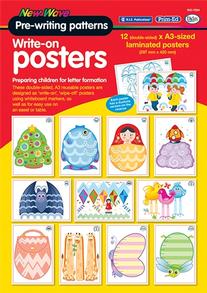-
0
Your cart is currently empty.
-
0
Your cart is currently empty.
-
Handwriting Workbooks (Cursive Writing)
Handwriting is a skill that requires practice and patience if a child is to develop a good cursive style.
At Prim-Ed Publishing, you'll find a range of handwriting resources that can be used in the classroom or at home. These handwriting worksbooks are designed to help children develop a good cursive style and provide clear instruction on how to write in a neat and consistent way.
Why teaching cursive writing is important
Whilst computers are becoming more and more dominant in society, cursive handwriting is still important. Handwriting is a skill that is transferred across all subjects learnt at school and is used in everyday life. Therefore, it is important that pupils are able to develop a handwriting style that is comfortable for them and legible to read.
There are also many benefits of teaching cursive handwriting, including the following:
- Cursive handwriting helps develop fine motor skills and hand-eye coordination.
- Developing cursive handwriting helps pupils to become fluent writers.
- Cursive handwriting requires the brain to process information differently than manuscript handwriting does, which can help pupils learn to read cursive writing faster than manuscript printing.
In order to help pupils develop cursive handwriting skills, Prim-Ed offers a variety of handwriting resources. These include pupil workbooks, workbooks, and teachers resources.
Each resource has been designed to help pupils improve their handwriting skills in a fun and engaging way.
How to implement a whole school approach to handwriting
A whole-school approach is vital to maintaining a consistent approach to the teaching and learning of handwriting from Infants level to 6th class. For a whole-school approach to be effective, certain documents need to be prepared prior to implementation. These include:
- A handwriting policy outlining the font, the time allocations, the expectations of the programme and of the pupils, how the programme will be implemented and evaluated, teaching strategies, and differentiation and assessment requirements.
- A progressive teaching and learning sequence within each class and across the school.
- A list of handwriting terminology with relevant explanations and examples.
- A document outlining the dotted-thirds line sizing and the writing implements to be used in each class.
- Any relevant forms that teachers may need to access regarding referrals to specialists.
Handwriting teachers guides
In addition to pupil workbooks and workbooks, Prim-Ed offers teachers guides to assist in teaching handwriting, including cursive writing. Teacher resources include assessments, activities, photocopiable pages and teachers notes.
The benefits of handwriting workbooks
Prim-Ed handwriting workbooks are suitable for all ages.
The beginner workbooks start with simple tracing exercises that help pupils gain control over their pencil grip and letter formation. Once pupils have mastered the tracing exercises, they can progress to the more complex workbooks.
These workbooks require pupils to write words, phrases and even short stories using cursive handwriting.
Handwriting workbooks are useful for several reasons. Workbooks can be completed by young children at home or in school, allowing them to build on their learning when away from the classroom. Pupils can also use workbooks as a base to develop their very own cursive handwriting style. Additionally, handwriting workbooks can be used as assessment tools to see if pupils are comprehending the material they are being taught.
Handwriting is a complicated skill that requires a great deal of practice. Therefore, specific workbooks are vital for handwriting practice.
Frequently Asked Questions
Is handwriting a part of the Irish Curriculum?
Yes, learning to write legibly and fluently is included in the Writing Learning Outcomes specified in the new Primary Language Curriculum.
At what age should children start learning cursive writing?
The New Wave Handwriting series starts by introducing the full cursive form to pupils in 1st class. At Junior and Senior Infants, preparatory work on each letter to allow this to happen easily is the priority.
How can teachers assess handwriting style?
Teachers can assess the handwriting style of pupils in a variety of different ways. These include:
- Viewing pupil handwriting samples to ensure cursive letters are joined together and appropriate spacing is used between words and lines.
- Observing pupils' cursive writing to discover the correct form has been used.
- Utilising pupil handwriting worksheets as an assessment tool.
Do older primary-school-aged children need handwriting worksheets?
From a developmental point of view, younger children benefit from handwriting worksheets. However, there is no harm in using them with children who are older if they need extra support. In fact, many teachers find that using handwriting worksheets helps pupils to improve their existing cursive styles. At Prim-Ed, you'll find handwriting resources suitable for Junior Infants all the way up to 6th Class.
What are some tips to help pupils develop cursive writing skills?
Here are some cursive writing tips for teachers:
- Allow pupils to master basic handwriting skills such as writing block letters and stroke order before moving onto cursive writing.
- Teach pupils how the cursive alphabet differs from manuscript printing in order to help them understand the purpose of cursive writing.
- Start teaching cursive writing by focusing on individual capital letters and lowercase letters first before joining other letters together and writing words and full sentences.
- Encourage pupils to use a cursive writing style that is comfortable for them.
- Provide plenty of practice opportunities for pupils to improve their cursive writing skills.












